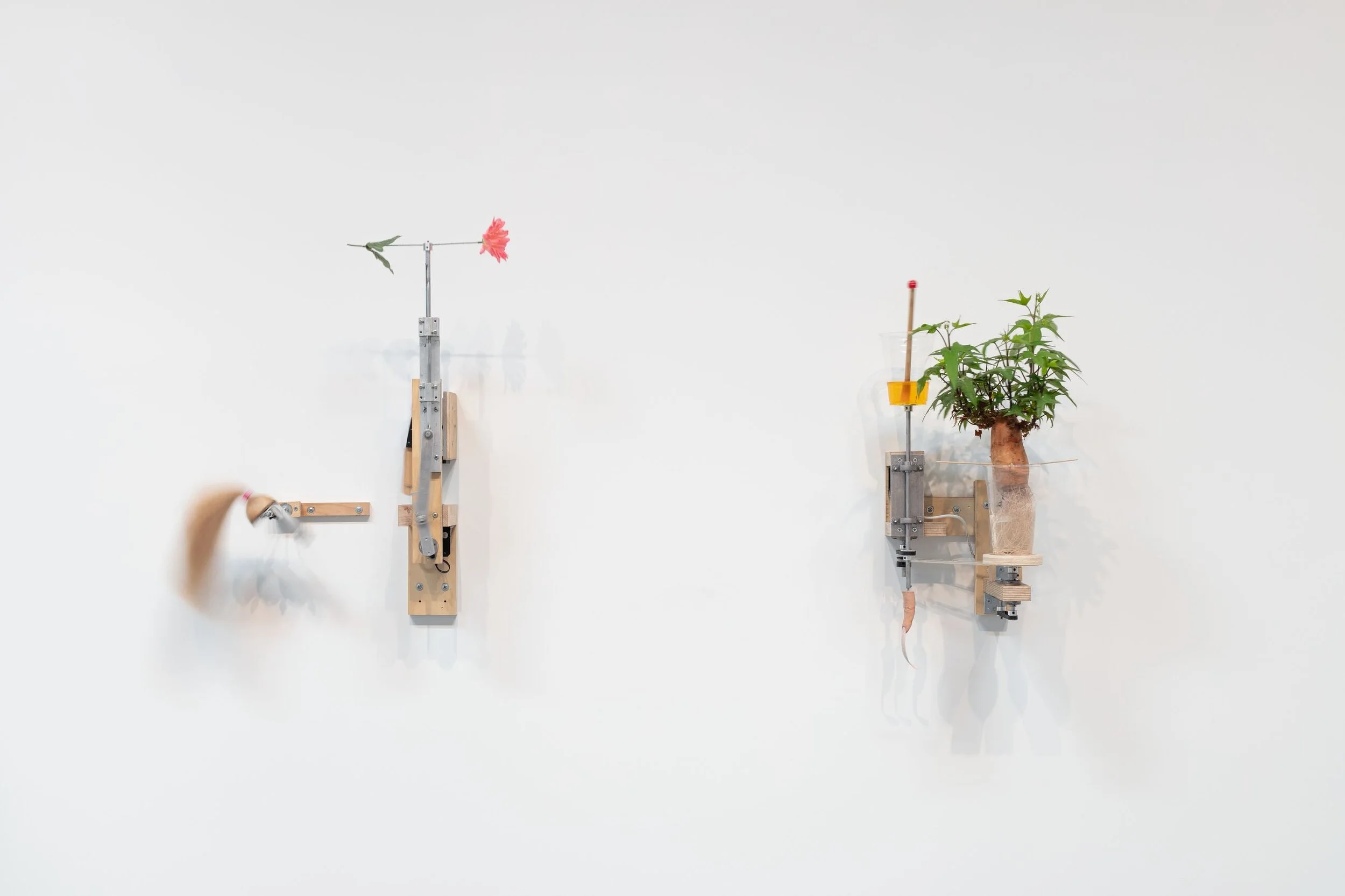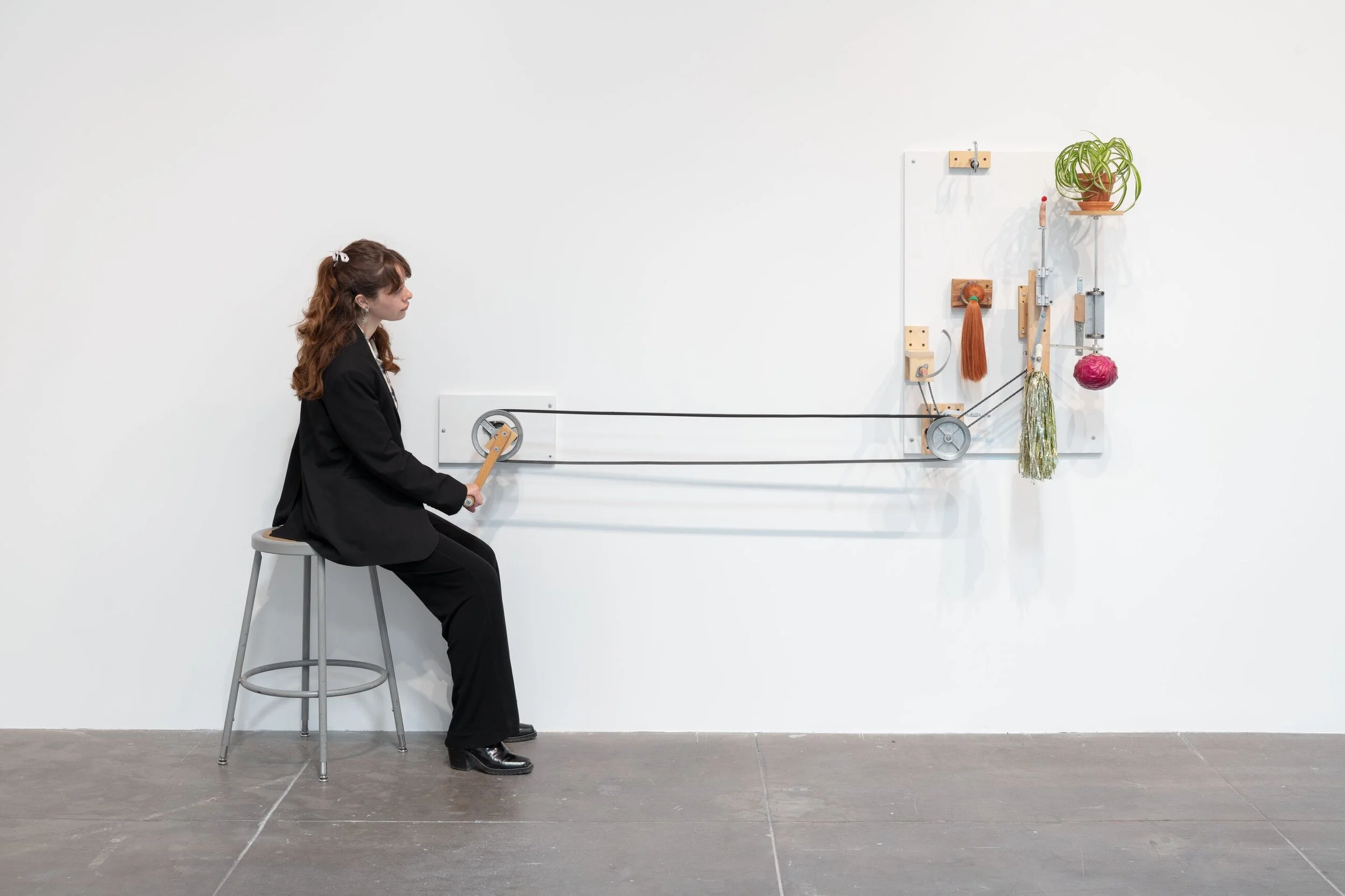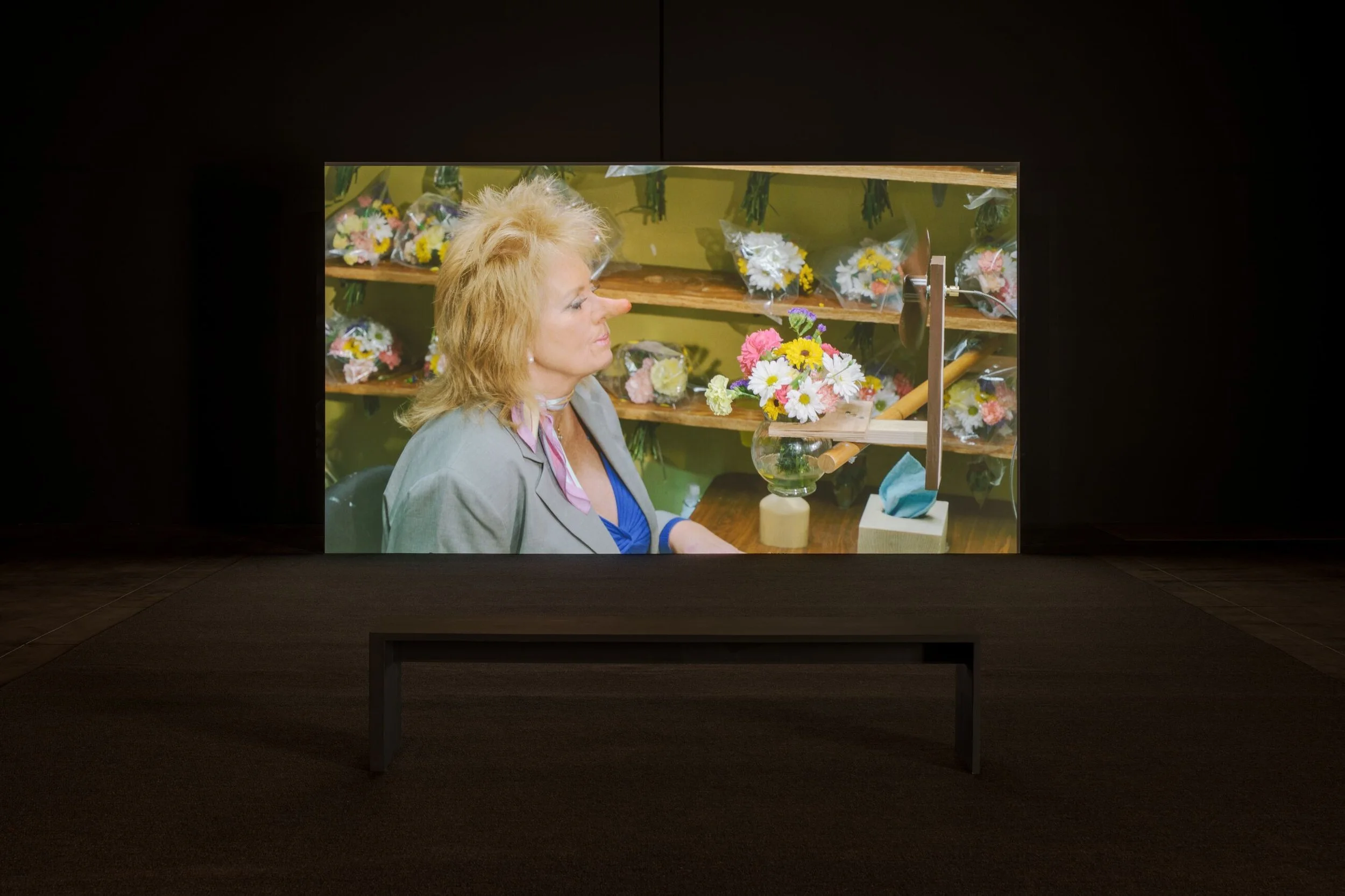Mika Rottenberg | Hauser & Wirth Los Angeles
Mika Rottenberg
Hauser & Wirth Los Angeles
23 Jun – 2 Oct 2022Introduction
This exhibition was the first major presentation of Mika Rottenberg’s work on the West Coast and the most comprehensive carbon footprint calculation of the artist's work to date. This research will help form the basis of carbon and waste reduction activities in our Downtown Los Angeles gallery and in future projects with the artist. Our team actively considered exhibition wall build waste and during the 2022 program found ways to adapt and reuse construction materials. Walls built for 2022 were reused. For the purposes of this exhibition additional walls of 139 sqm were constructed but were not demolished following the show.
This exhibition’s Climate Impact Report (CIR) is published on the artist-led sustainability platform Artists Commit. Launched in November 2021, the CIR concept was created by Artists Commit. Written in March 2023, this is the third in a series of CIR’s published by Hauser & Wirth.
Hauser & Wirth’s Climate Policy
In line with the Paris Climate Agreement of the United Nations, we are reducing our carbon emissions by at least 50 percent by 2030. Since making our commitment, we have reduced our emissions by 9 percent and continue to drive actions to accelerate meeting our target. Reductions are happening by switching to renewable energy, transitioning to LED lighting, purchasing electric vehicles and tracking carbon emissions and waste associated with our air freight.
Commitments
• Reduce our greenhouse gas emissions by a minimum of 50 percent by 2030 in line with the Science Based Targets initiative (SBTi). This includes reducing our freight, business travel and exhibition construction emissions
• Support Strategic Climate Funds, projects that preserve existing forests and positively impact communities backed up by climate justice initiatives
• Actively promote and provide a platform for industry collaboration
Measurement
Calculating our emissions has been one of our first actions. By better understanding our impacts we have been able to manage them more effectively. Our scope 1 and 2 (energy and fuel) and our scope 3 (flights, freight, exhibition construction and other) emissions are independently audited by ERM. Based on these metrics our reductions are directed by a comprehensive strategy across our galleries.
Science Based Targets initiative (SBTi)
By understanding and measuring our impacts, we are taking responsibility for our commitment by enrolment in the Science Based Targets initiative. This means that we have demonstrated an externally validated set of emissions and targets with a pathway to achieving our reduction goal of 50 percent by 2030 in line with the Paris Agreement.
Energy
We are working hard towards 100% fully renewable energy and already have switched our providers in the New York, UK, Switzerland and Spain, saving 600 tCO2e since we began to track our emissions in 2019. Our gallery team ensure that we embed energy conscious behaviour into our operations through an internal program called Hauser & Wirth Switch Off. We have completed detailed energy audits of our key locations and are implementing the recommendations of these studies by transitioning to LED lighting; optimising our heating and cooling systems and switching to electric vehicles where possible.
Exhibition carbon budgets
In 2022, we started gathering data specifically on the emissions of our exhibitions, to better understand the carbon costs of freight, packing, crating, construction and travel associated with exhibitions. This data enables us to set exhibition carbon budgets and to analyse and cap impacts. In 2023, our team are identifying measurable reductions based on these budgets and are continuously reviewing the efficacy of these tools. The plans for the carbon budgets have been developed in consultation with internationally recognised consultants, the Carbon Accounting Company.
Strategic Climate Funds
As a core element of our sustainability plan, we support Strategic Climate Funds. This approach reflects current research by Art to Acres and other environmental advisors to the GCC to differentiate between conventional carbon offsetting and funds that focus on eco-system preservation and positive impacts to communities directly affected by climate change. Importantly, our support of Strategic Climate Funds conserves existing forests and is backed up by climate justice initiatives. This support is in conjunction with the reduction of our impacts using lower carbon logistics initiatives that target our main source of emissions (shipping and packing) and our investment in internal changes, namely energy efficiency programs. Two examples of high impact Strategic Climate Funds that have received our donations include Art to Acres and ClientEarth.
Industry Collaboration
Gallery Climate Coalition
We are committed to facilitating dialogue and sharing information with the global art community to encourage our sector’s collective shift towards environmental sustainability. We support the development of a meaningful and industry-specific response to the climate crisis and have been patrons of the GCC since 2020. As active members of the GCC, we align with their targets and reduction strategies. Our sector needs collective, shared standards of sustainable practice and the GCC has been instrumental in evolving the resources, tools and research driven reports that have aided the development of Hauser & Wirth’s approach to environmental sustainability.
Galleries Commit
As participants in the Galleries Commit Climate Action 8×8 Campaign, Hauser & Wirth have committed to acting on 8 key areas of climate impact in 2023.
Sustainability In Action
Our Sustainability In Action conference in 2022 created a dynamic platform for action-focused industry collaboration, dialogue and knowledge sharing. It brought together artists, museum professionals, collectors and gallerists with leading voices from the art sustainability sector. It followed four key themes, exploring the artists and commissioners who are working towards environmental best practice; collectors who are actively supporting climate conscious approaches; galleries that are taking immediate action; and organizations that are implementing changes within the supply chain.
Exhibition Overview
Hauser & Wirth Los Angeles hosted the first major presentation of Mika Rottenberg’s work on the West Coast to celebrate the global release of ‘Remote’, her first feature-length film, made in collaboration with producer and writer Mahyad Tousi. The exhibition opened on June 23 and included video works, ‘Spaghetti Blockchain’ (2019), ‘Cosmic Generator’ (2017), ‘NoNoseKnows’ (2015), and ‘Sneeze’ (2012), in addition to new kinetic sculptures, drawings, and installations.
Rottenberg illustrates the absurdity of humanity's rampant production, distribution, and consumption of objects by juxtaposing existing industry with her own, often unexpected, manufacturing systems. ‘I think of objects in terms of the processes behind them and the idea that humankind is captured in everything around us. I want to make these processes more visual. If art has any power, it is in making things visible.’ From pearl and food cultivation to the mass-production of wholesale plastic items sold in China, Rottenberg excavates the processes humans invent to create a sense of control.
Carbon Emissions:
The exhibition’s carbon emissions were assessed according to Scope 1, 2 and 3 by the Carbon Accounting Company (CAC). The methodology for the exhibition emissions quantification follows the principles and methods of The GHG Protocol Corporate Accounting and Reporting Standard. The lifecycle emissions quantification of construction materials follows the principles of the ISO 14040:2006 Standard.
All data was collected and provided by Hauser & Wirth colleagues either directly in the data collection workbook provided by CAC, or in separately consolidated communications. While it is assumed that the data entered by Hauser & Wirth was accurate and complete, minor leakages in the Scope 3 carbon category are anticipated.
Areas Calculated
Further narrative about the carbon emissions of the exhibition
SCOPE 1
Propane Mobile Combustion: 0.65kg tCO2e
Fugitive Emissions from Air Conditioning: 0.98 tCO2e
SCOPE 2
Grid Electricity: 80.42 tCO2e (location-based), 82.31 tCO2e (market-based)
SCOPE 3
Freight: 12.17 tCO2e
There was a mix of air and road freight. Air freight weighed 243 kg and road freight was 54,863 kg, distances of 5,753 and 4,273 km were travelled respectively. Air freight emissions were calculated using volumetric weight of the shipment from New York. Calculating the carbon footprint of road transport has accuracy limitations because it is not accounted for by vehicle type. The calculation includes both inbound and outbound shipments.
Employee, contractor and artist travel: 2.42 tCO2e
The only travel that’s been included in this report in the air travel, with the total distance amounting to 23,667km.
Visitor travel: 133.6 tCO2e
There was a total of 24,982 visitors who traveled by car, and it is assumed that 20% travelled in a shared vehicle with the average distance of 20 miles. The vehicles are assumed to be average size passenger vehicles with average fuel type as defined by US EPA. Total distance travelled was 399,712 km.
Event Food & Beverage: 0.09 tCO2e
There were 2 catered events with a total of 49 guests.
Exhibition construction: 3.03 tCO2e
Materials used in the exhibition included: 30 gallons of decorative paint, 3,500 lbs of drywall, 2000 lbs of plaster, 200 lbs of plywood, 300 lbs of stucco, 360 lbs of steel studs, 200 lbs of carpet, 50 lbs of chicken wire, 5 lbs of styrofoam, and projection screens (15 lbs).
Total Calculated Emissions: 258.53 tCO2e
Waste Report
Using a material afterlife checklist, we categorized the destination of material used in the exhibition.
Recycle: items placed in the recycling bin
Non-construction dry mixed recycling (5,500 litres)
Landfill: items sent to a landfill
Non-construction general waste to landfill (5,500 litres)
Waste disposal generated 0.17 tCO2e
Collective Action
Share a Climate Impact Report at artistscommit.com.
Share what was learned in the Report to audiences.
Ask project partners and collaborators about their climate policies, commitments, or priorities.
Learn from what other projects have done, connect with other institutions or artists to ask for advice, acknowledge them in your report.
Reach out to other organizations or local networks doing this kind of work:
Galleries Commit
Gallery Climate Coalition
Propose others do a Report at the same time.
Offer to be available to advise or support other artists or presenting partners who want to do a climate impact report for the first time.
Make sure all artists you work with know that the Climate Impact Reports is an available tool.
Use the report to refine future practices.
Additional Notes/Closing Thoughts
This is a further Climate Impact Report (CIR) conducted with the support of Artists Commit and the first conducted with our gallery team in Los Angeles. As follow up to the report, we plan to run a workshop with our local team so they understand the findings of the report and can incorporate climate conscious choices into future exhibitions. Alongside the carbon budgets that Hauser & Wirth is using for exhibitions in 2023, colleagues can use the CIR document as a base to consider the full sustainability spectrum of a specific exhibition. It is interesting to reflect on how decisions about wall build construction have an impact and what the gallery team can do to reduce waste going forward.
Rendering used for planning installation at Hauser & Wirth Los Angeles, 2022
Exhibition Info and Credits
Carbon Emissions Metrics Prepared by: Fernando Vargas, Facility Manager (Hauser & Wirth), Jennifer Tokash (Registrar), Nathan Ellefson (Art Handler), Peter Mundwiler (Head of Art Handling), Elaina Breen (Head Registrar), Carl Johns (Director of Operations)
CIR Prepared by: Ian Lipton, Carbon Accounting Company, Cliodhna Murphy, Global Head of Environmental Sustainability, Hauser & Wirth and Nataliia Zvirkova, Environmental Sustainability Coordinator, Hauser & Wirth.
CIR Reviewed by: Amelia Brown (Artist Liaison, Hauser & Wirth), Haley Mellin (Art to Acres)
Exhibition link: https://vip-hauserwirth.com/gallery-exhibitions/mika-rottenberg/
All image credits: Installation View Mika Rottenberg, Hauser & Wirth 2022. Photo by Zak Kelley.
Thanks to Artists Commit team members Laura Lupton and Deville Cohen.









